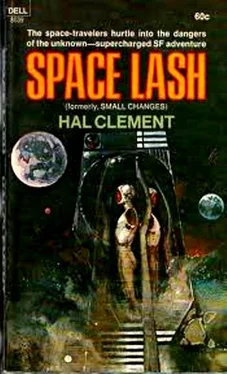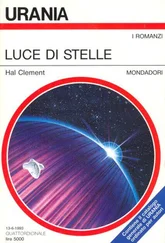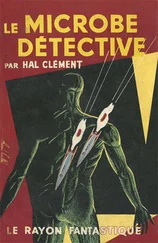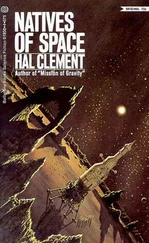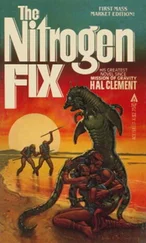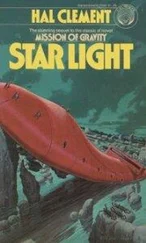Hal Clement - Space Lash
Здесь есть возможность читать онлайн «Hal Clement - Space Lash» весь текст электронной книги совершенно бесплатно (целиком полную версию без сокращений). В некоторых случаях можно слушать аудио, скачать через торрент в формате fb2 и присутствует краткое содержание. Год выпуска: 1969, Жанр: Фантастика и фэнтези, на английском языке. Описание произведения, (предисловие) а так же отзывы посетителей доступны на портале библиотеки ЛибКат.
- Название:Space Lash
- Автор:
- Жанр:
- Год:1969
- ISBN:нет данных
- Рейтинг книги:3 / 5. Голосов: 1
-
Избранное:Добавить в избранное
- Отзывы:
-
Ваша оценка:
- 60
- 1
- 2
- 3
- 4
- 5
Space Lash: краткое содержание, описание и аннотация
Предлагаем к чтению аннотацию, описание, краткое содержание или предисловие (зависит от того, что написал сам автор книги «Space Lash»). Если вы не нашли необходимую информацию о книге — напишите в комментариях, мы постараемся отыскать её.
Space Lash — читать онлайн бесплатно полную книгу (весь текст) целиком
Ниже представлен текст книги, разбитый по страницам. Система сохранения места последней прочитанной страницы, позволяет с удобством читать онлайн бесплатно книгу «Space Lash», без необходимости каждый раз заново искать на чём Вы остановились. Поставьте закладку, и сможете в любой момент перейти на страницу, на которой закончили чтение.
Интервал:
Закладка:
This was “Program A” which was now in progress. Electromagnetic waves of almost five hundred different frequencies, ranging from the blue part of the visible spectrum to the output of a huge electromagnet fed by an alternating current source with a three-hundred-second period, were propagating away from the Ymyrgar, groping their way through the not-quite-empty billion kilometers or so which separated the little tender from her sister. Some of the frequencies had been selected for their ability to interact with the atoms and ions known to occupy the space, some for the fact that they would not. Some would be absorbed and analyzed by the apparatus aboard the Anfforddus, some would be reflected back toward their source to create the standing-wave patterns needed for Program B. All would represent a waste of energy if the two tiny ships changed their relative positions by one part in ten billion billion.
Lights on the control consoles aboard the Holiad recorded the behavior, microsecond by microsecond, of each separate frequency generator; but the one which Toner never let out of his sight was that which kept track of the interferometer on the Anfforddus. This 'light shone yellow as long as the original pattern of fringes remained unchanged; a one-fringe shift one way would carry it into the red; a similar change in the other would turn it violet. So far, while there had been at times a suspicion of green or orange in its tint, it had held within the English language limits of yellow.
“I think you can relax a little,” remarked Ledermann. “All the general run of disturbances should have had their licks by now; A has been cooking for over half an hour. Unless Hoey or Luisi has a fit, their ships can hardly move enough to make trouble.”
“They both had EEG checks before they were hired.” Toner was not joining in any levity, yet. “I'm not worried about that possibility.”
“Then why not take it easy? Surely you're not worrying about a meteor.”
“Well — comet nuclei are found pretty far from suns, but I really wasn't thinking of anything specific. It's just that so little need go wrong to wreck the whole works. Program A isn't so bad, in spite of the precision we need; but when B gets going it will really mean something. I can't keep my mind off that.”
Ledermann nodded. Program B was the experiment itself — the check on the Toner hypothesis. In assuming that non-statistical forces existed which tended to start interstellar matter drawing together into protostars, the astronomer had not fallen back on mysticism. He had computed many combinations of electric and magnetic fields which should have such an effect, and which might reasonably — or at least conceivably — exist along the arms of the Milky Way. The wave patterns of Program B had been designed from these computations. Naturally, phenomena as complex as, say, the human nervous system or even the circuitry of a television set or the measuring patterns of Program A would be no improvement on pure chance as an explanation for star formation; such things were too improbable by any standards. Toner's fields were simple enough so that, in his opinion, they were more probable than random gas and dust concentrations. They were also complex and extensive enough so that looking around for examples of them already in existence seemed impractical — so far. Of course, if Program B showed that such fields would, or could, produce the results Toner expected, he would have little trouble financing such a search.
If the program failed to give the results Toner hoped for, Ledermann was both unsure and uneasy about what to expect. Few men can abandon a favorite hypothesis abruptly and completely, and the need to do so can have painful effects.
Actually, Toner would not be forced to such an extreme at first; many more variations on the original theme would have to fail before the whole idea would have to be abandoned. What bothered Ledermann was the doubt that the foundation would go along with any such extension of the project and how Toner would react if it refused.
Actually he needn't have worried. The director was philosophical enough to take such a problem in his stride. Since the younger man had no way of knowing this, he watched his console with even more anxiety than his director — in spite of what they had both been saying.
But the green lights stared unwinkingly back at them, as the waves spread across space. No news, with the proverbial implication. The clock was the only instrument which showed change; the clock, that is, and two human nervous systems.
“Stuff coming in from Hoey's receivers,” Ledermann reported abruptly. Toner nodded.
“On time,” was his only answer. Neither bothered to ask, or to say, what sort of stuff was coming in; the data was no more meaningful to human senses than were the photons which carried the first Mariner pictures from Mars. The main thing was that news was coming in; it was being recorded; it could, in due time, be decoded; and — Program B was due to start.
Both men sat up a little straighter and stared more tensely at their consoles as the light patterns began to change.
Simultaneously — the word was as nearly truthful as it had ever been in human history — sets of electromagnetic fields began to grow around both the Ymyrgar and the Anffordclus.
Neither set was complete by itself, but this interference would produce something which Ledermann thought of as a huge lens. The analogy was a poor one geometrically, but has some excuse from a functional viewpoint. Drifting slowly with respect to the surrounding gases, many of whose atoms were ionized, it should — if Toner was right — tend to deflect their relative motions toward its own “optical axis.” To that extent, Toner's idea was a. simple one. The precise pattern of fields which should have the desired effect was somewhat less so, as any engineer who has been involved with an electron microscope would expect.
Each lens” of the series making up the program was to be followed by a set of reading patterns similar to those of Program A, so that its individual effect on the motion of the nebular particles could be measured. In principle, the whole thing was easy…
“Intervals seem to be right.” Ledermann dredged a little good news out of his light pattern. “Four seconds, plus or minus ten to the minus tenth. Interlens distances are within tolerance, I'd say.”
“If we haven't been too grossly off in computing the refractive index of the nebula…"
“Which is handled automatically by the original A measures, as I understood the plan. Calm down, boss.”
“All right. You're talking a little louder than usual yourself. I still wish you'd invent a method for using the communicator medium for direct viewing; we could see whether these things are building right, instead of having to infer from generator behavior…"
“Maybe we could. I'm a conservative; I still buy the Uncertainty Principle. Even if we could do anything with the medium which would make it react to something besides a communicator crystal, I bet it would affect the thing we were trying to measure.”
“It doesn't affect the crystals — just the space around them.”
“Not measurably. Has anyone tried to check on them, to within fifteen figures of what we're doing now?”
“Not as far as I know. I — Dick! What happened then?”
Ledermann didn't know either. At least, he didn't know in the sense that Toner wanted to. Like the director, he had seen every light on his console except the one indicating tender separation turn a solemn red for a full second, and then switch back to green. If they had been looking away for that second, the men would not have known that anything had ever been wrong; after the event, the lights stared back at them, apparently unchanged.
Читать дальшеИнтервал:
Закладка:
Похожие книги на «Space Lash»
Представляем Вашему вниманию похожие книги на «Space Lash» списком для выбора. Мы отобрали схожую по названию и смыслу литературу в надежде предоставить читателям больше вариантов отыскать новые, интересные, ещё непрочитанные произведения.
Обсуждение, отзывы о книге «Space Lash» и просто собственные мнения читателей. Оставьте ваши комментарии, напишите, что Вы думаете о произведении, его смысле или главных героях. Укажите что конкретно понравилось, а что нет, и почему Вы так считаете.
